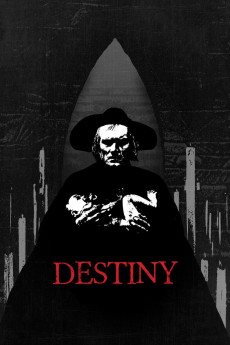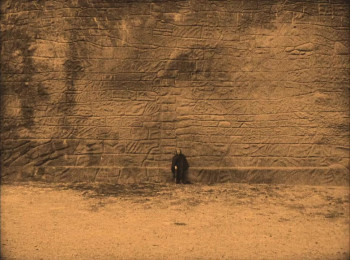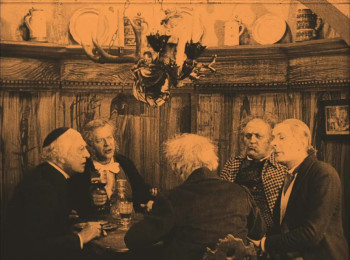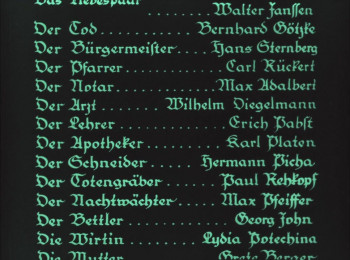Destiny
1921 [GERMAN]
Action / Drama / Fantasy / Horror / Thriller

Plot summary
As a young couple stops and rests in a small village inn, the man is abducted by Death and is sequestered behind a huge doorless, windowless wall. The woman finds a mystic entrance and is met by Death, who tells her three separate stories set in exotic locales, all involving circumstances similar to hers.
Director
Top cast
Tech specs
720p.BLU 1080p.BLUMovie Reviews
if only movies today used their sfx so well
"Love is Stronger Than Death"
The biographical entry for Fritz Lang in the invaluable World Film Directors reference book offers a revealing quote. It seems that when he was a teenager he became gravely ill, and at the peak of his delirium experienced a vivid hallucination. As Lang later described it, "I saw myself face to face, not terrifying, but unmistakable, with Death . . . I don't know whether I should call the feeling I experienced at that moment one of fear. It was horror, but not panic. I recovered quickly, but the love of death, compounded of horror and affection . . . stayed with me and became a part of my films." Lang, who was Austrian, served in the Army during the First World War where he saw considerable combat and, of course, encountered death on a horrific scale. (He also lost the use of his right eye.) While still in the service he launched his career in the movies by submitting screenplays to producer Joe May, and soon afterward acted in two of May's films, playing the Angel of Death in "Hilde Warren und der Tod." Lang began directing in 1919 and was successful almost immediately but remained largely unknown outside Germany until his first genuinely personal project, "Der Müde Tod," burst upon the scene in 1921 and became an international sensation. Lang's timing was perfect, for in the troubled period following the war interest in spiritualism and the afterlife was intense. This film represented the director's most thorough exploration of the fever dream of his adolescence, for here Lang utilized elements gathered from the myth and folkloric traditions of various cultures to explore a question posed by the leading lady to the Grim Reaper himself: Is Love stronger than Death?
In the opening scenes we're introduced to a happy young couple who intend to marry. On their travels they encounter a stranger, a gaunt and unsmiling figure in a black cloak who is heading for the same village that is their destination; the very sight of him darkens the atmosphere and kills their joyous mood. The stranger is Death himself, who seeks to purchase land owned by the village elders. The stranger informs the elders that he is weary-- from his exertions during the Great War? --and wishes to settle down. Once he buys land the stranger erects an estate surrounded by an impossibly high wall, a wall with no apparent door or entryway, and his next act is to claim the soul of the Young Man. The Young Woman searches the village and fails to find her fiancé, but when she takes poison she is able to pass through the wall and confront Death. He takes her to a room filled with candles representing the souls of humanity. When the Young Woman demands that Death restore her fiancé to life he agrees to do so only if she can defeat him, and he gives her three opportunities.
The Young Woman's three chances to defeat Death unfold in the form of three tales set in disparate parts of the world in three different historical periods: Persia in the days of the Caliphate, Renaissance Venice, and Imperial China. Three incarnations of her Young Man are threatened with extinction, and three incarnations of the Young Woman have a chance to rescue him. These stories make up the bulk of the movie and each is longer and more elaborate than the one preceding. Eventually, when the Young Woman proves unable to beat Death she is given one final chance to win back her fiancé, but when she finds the price demanded of her too high to pay, the lovers are nonetheless reunited in the afterlife in a strangely gratifying finale.
The historical adventures take place in highly stylized worlds, especially the Chinese segment, but even the film's Middle-European framing story features expressionistic structures that resemble stage sets, just as the (unnamed) young man and woman at the center of these events are meant to embody folkloric archetypes rather than dimensional characters. Lang's Persia, Venice and China suggest a child's notion of what these places might be like; the palaces have the look of enormous doll-houses. And of course the magical element is derived from fairy tales: the Chinese magician summons a miniature army of soldiers to amuse the Emperor, and is himself later turned into a cactus (one of the film's most memorable and disturbing images), while the Emperor is a fairy tale villain with grotesquely long claw-like fingernails. "Der Müde Tod" is, with Maurice Tourneur's 1918 classic "The Blue Bird," one of the cinema's first great flights of fantasy, suffused with imaginative effects and whimsical touches but undergirded with a deep sense of sadness.
Like many silent films this one has been shown in a variety of editions over the years, but the restoration completed in 2000 that is now available on DVD from Image Entertainment appears to be the closest to Lang's original version. This edition recreates the color tints of 1921 and the type-faces of the original title cards, which attempted to capture the exotic calligraphic styles of the three foreign lands of the adventure stories. (My only criticism is that I found the "Persian" type rather difficult to read.) This disc also boasts a beautiful score by the Mont Alto Motion Picture Orchestra, music that enhances the visuals without drawing undue attention to itself. For those who can't attend a public screening of this rarely shown gem the Image DVD is about as good as silent movies get on the home screen; and Fritz Lang's "Der Müde Tod" is one of the most fascinating silent movies.








